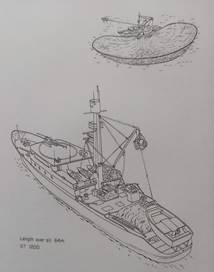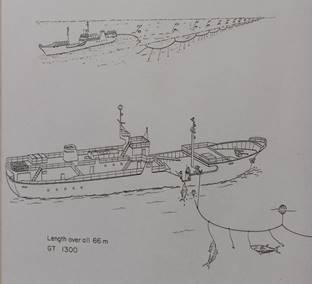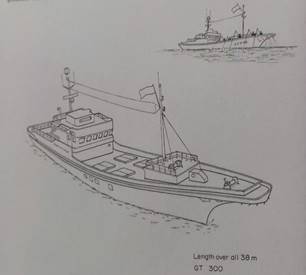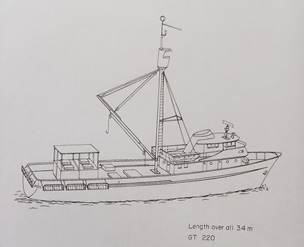
The CALANCA and her sister ship CASTANEDA belonged to a series of small refrigerated ships built by the N.V. Werf "Gusto", Schiedam, Netherlands (near Rotterdam). The shipyard also belonged to the Thyssen-Bornemisza group. The CALANCA was launched on 18.12.1961 for H.H. Thyssen and was delivered to the owner company St. Gotthard Schiffahrts AG, Chur, on 30.03.1962. The refrigerated ship was registered under the Swiss flag (register No: 68, call sign: HBFJ). Calanca is a valley and a political municipality in the Italian-speaking part of the canton of Graubünden.
The management was taken over by Suisse-Outremer SA de Gérance et d'Affrètement Maritimes, Geneva, and from September 1963 the company moved its domicile to Zurich and now called itself Suisse-Outremer Bereederungs- und Befrachtungs AG in German language.
After delivery, the CALANCA sailed together with her sister ship CASTANEDA in the Dutch reefer pool of Dammers & van der Heide, the entire crew came from the Netherlands. The CALANCA first sailed bananas from Conakry, Guinea (still a strictly socialist country under its first president Sékou Touré) to Hamburg, from where they were taken by rail to Prague in Czechoslovakia.
After an intermediate voyage from Reykjavik to Philadelphia in May 1963, the CALANCA transported bananas of the Bonita brand from Ecuador (Guayaquil, Porto Bolivar, Esmeraldas) through the Panama Canal to the East Coast of the United States, mainly to Galveston, Tampa and Gulfport, for Grupo Noboa (Luis Noboa, Ecuadorian entrepreneur 1916 - 1994) for years. From 1968, the ship brought bananas from Angola (Lobito and Luanda) to Lisbon.
After initially having a complete Dutch crew on board, they were slowly replaced by Swiss, Spanish and Yugoslavians. In keeping with the sailing area, local seamen were also hired, such as Ecuadorians and Africans.
At the end of 1970, the big change took place, the CALANCA now sailed on behalf of American companies (e.g. Starkist and Bumble Bee Seafoods), following the tuna fleets and bringing tuna of all sizes mostly from West Africa to the canneries in Puerto Rico and California. From time to time, the refrigerated ship also called at ports on the Pacific coast of South America these voyages to the South Seas were probably more the seamen's dreams. The fish were usually taken over directly from the American, Canadian and Korean fishing trawlers on a protected roadstead in the harbours, occasionally they were also loaded from a cold store.
Stories from the crew mess:
It was understood that the charterer sub-chartered the CALANCA and it was repeatedly told that the charterer supposedly earned more that way than Suisse-Outremer. Of course, this made the director Lüssi very unhappy and is said to have made him very angry. Whether this was true is not known with certainty, but it was mentioned again and again on board. In the spring of 1976, the ship was due to sail to Pago Pago, US Samoa, to load fish, but there were problems with the tail shaft. The charterer, however, was "not amused" and sent the freighter to Taboga instead to load fish for the US and Canada. Two voyages later in the dock in Willemstad, the fault was rectified. To the great joy of the whole crew, no superintendent from the shipping company came to supervise the docking. Those were good times, but unfortunately the ship was sold. Nobody really wanted to pay off, but nobody wanted to sail with the Greeks, even though they tried to hire us.
At the beginning of 1977, the owners sold the ship to the Greek shipping company Albafrigo Navigation Co. SA, Piraeus, and the management was taken over by Alba Shipping Co. SA, Piraeus. The ship was named ALBAFRIGO and registered under the Greek flag in Piraeus (call sign: SV4178).
On a voyage from Puntarenas, on the Pacific coast of Costa Rica to Port Canaveral in Florida, an explosion occurred in the crankcase of the main engine while still on the Pacific side on 01.03.1980, severely damaging the engine. The salvage tug ATLAS towed the vessel into the port of Balboa, Panama on 14.03.1980. The tuna cargo was transferred to the Dutch EMELY (991/79) and the ALBAFRIGO anchored in the roadstead. In March 1982, Panaconti Shipping Co. SA, Panama bought the reefer and tried to find a replacement engine, but failed. As late as 14.03.1985, the ship was observed in the roadstead of Panama City at anchor with her side ports open. In the same year, the ship was sold to Peruvian interested parties, then resold to a Colombian scrapping company at the end of 1985. They towed the wreck to Cartagena de Indias (Cartagena on the Caribbean coast of Colombia), where she was scrapped.
SwissShips HPS, MB November 2022
Additional information and stories
Personal report by Markus Berger
On 03.03.1976 I signed on in Ponce, Puerto Rico on the CALANCA and the problems with the tail shaft were already present. The shaft had just returned from land that day (via the tonnage hatch, screwed bulkhead, the cabin corridor down into the engine room), the cause was probably the heavy storm that had raged on the previous voyage to Cambridge (Maryland) and St. Andrews in Canada (New Brunswick).
On the evening of 03.03.1976 we made a sea trial and it was probably not to the Engineers satisfaction and the shaft was given ashore again. After the re-fitting we went to Taboga, Panama instead of the much more distant Pago Pago and loaded Tuna from American and Canadian seiners. The American seiners were very nice ships, one of our Swiss sailors signed on, on one of them. The Canadian ones looked rather dirty and less inviting. When we arrived in Taboga, the CASTANEDA (Peter Schickli was on board as 2nd officer) and the Dutch sister ship RISA PAULA were already there.
Due to the harsh winter in Canada with the extremely low temperatures, all the paint on our vessel had cracked and after the storm the whole ship was covered with rust markings in and about these cracked areas. The ship looked really awful when I signed on and there was a lot of work to do to repair this paint damage. Fortunately, on my first trip the weather was reasonably good, again we went to Cambridge and St. Andrews. There was nothing there, just a pier, a fish factory full of Catholic women from Puerto Rico. In the pub you were only served alcohol if you ordered something to eat. But there was a car for the crew (the old man and the officers also had one) which the agent provided. Since the border to the USA was close and unclear, two crew members got lost and unintentionally ended up in the USA, which led to big problems and brought them into an American jail for a short time.
The unloading of the cargo in Canada was slow and the deck and night watch had a lot to do, as the tidal range was over 11 metres and the gangway had to be placed on the bridge deck at low tide and back on the main deck at high tide. From the main deck it was a steep descent to the pier. Apart from the magnificent natural environment, the shore leave was nothing for a young sailor. In St. Andrews, the place for any social activity was the one and only pub, there were about 10 women for every 50 men, many of them weighing about 100 kilos, and only to be considered beautiful with a lot of alcohol.
We then made another trip with fish from Taboga to Ponce and Mayaguez. In Mayaguez we were allowed to visit the fish factory and were told that our fish would only become animal food for the Americans, which really shocked me at the time, “this beautiful fish is only for cats and dogs”, I found that disgusting.
After that, we went to the dock in Willemstad, Curacao. There was an Ecuadorian tanker from Flopec in the dock and our Ecuadorians celebrated with the crew from there, only to find out the next day that they had been robbed. Well, that's how the Ecuadorians were back then. Then we made a trip to Puntarenas in Costa Rica. We loaded the fish at anchor in the bay far from land. This was because it was feared that sharks would be attracted by the brine used in the fish storage tanks onboard the fishing vessels. The loading work only happened during the night, because during the day it was unbearably hot in the bay. The voyage went to Astoria at the mouth of the Columbia River in the state of Oregon. We had a warm and friendly reception by the local people. The stevedores would drive us into the town where the local drinkers at the pub would send over rounds of drinks paid for by themselves. That was the only city in the USA where I liked it after all. Most of the inhabitants were of Scandinavian descent, we were told. By the way, the pilot came early in the morning with a big salmon, which I had to hoist up first and only then did he come on board. The cook prepared it fresh for breakfast. It was also here that we encountered a longer than expected stay. This was because the fish was so frozen that they had to be pulled apart by means of ropes and the winches.
Afterwards we went back to Ponce via Taboga and from there to Manta and La Libertad in Ecuador to load fish again for Ponce and Mayaguez. Then we went to Tema with a partial load of food for the Americans there and relief goods donated by the Yanks, such as rice and cooking oil for the local population. Later, the local ship chandler sold such food, marked as donated goods, back to us as stores.
Because the Japanese and Koreans had not caught any fish there with their longliners, we made a trip for the Ghanaians to Bathurst (now Banjul) in Gambia to load packed fish from the Ghanaian fish cooling and factory ship AGYASI MANKO after 14 days at the pier in Tema. However, the packages were very badly tied up and the small fish were lying all over the deck and in the holds, a huge mess and the people in Gambia stole everything that was not nailed down, even the guy ropes and a preventer. This led to a cargo stop and suddenly, miraculously, the preventer was back), it was a real horror trip and my sympathy for the Africans has again decreased noticeably after all the theft on board.
In 1975, before I signed on, the ship made a voyage with fish from Peru to Chile and then loaded apples in Valparaiso for Buenos Aires and Montevideo. After that, they sailed to Rio and from there I think to Africa, but I don't remember these stories very well. It was a long time ago.
Tuna fishing
The Tuna genus, like Atlantic Blue Fin, Yellow Fin, Blue Fin, etc. is distributed throughout all tropical, subtropical and temperate zones of the oceans and seas. The tuna is a predatory fish and is divided into eight main species. They grow from 0.5 m / 10 kg to 4.5 m / 700 kg and live in schools or "shoals", larger specimens are known to live alone.
Tuna are mainly caught in three different ways:
- Purse seine vessels
- Long-line vessels
- Pole and line vessels

Purse seine vessel
A type of vessel that originated in the USA, but is now also built and used by other nations. A crow's nest high up on the mast is used as a lookout to spot schools of tuna. Sometimes a small helicopter is also used. The skiff, the big, strong boat at the stern, is used to pull the purse seine net around the school of fish.

Long-line vessel
Koreans and Japanese often work with this method. This is used to catch the beautiful and large tuna, which have a good market value.

Pole and line vessel, Japanese type

Pole and line vessel, American type
StarKist
The largest producer and marketer of canned tuna in the USA, but today also of other food products. The company's roots go back to 1910, when a Yugoslavian immigrant took a fishing boat to San Pedro, California to catch tuna and built up a large company over the years. Today, StarKist is part of the South Korean corporation Dongwon.
StarKist has (or had) its own fish processing and canning factories in US Samoa, Puerto Rico (Mayaguez and Ponce), and Terminal Island, California (near Long Beach, closed since 1985). The US Army was also a major consumer of the canned goods. "Charlie the Tuna" was a very well-known advertising figure in the US.
Sources:
- Federal Archives, Bern
- Guildhall, London
- FAO, Food & Agricultural Organisation, Rome
- Wikipedia
SwissShips March 2023